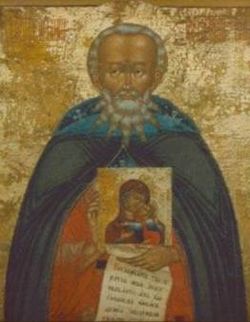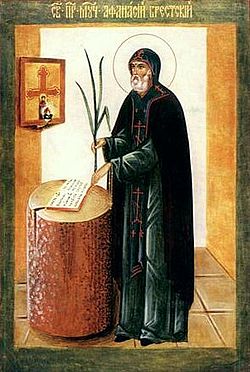Top Qs
Timeline
Chat
Perspective
July 20 (Eastern Orthodox liturgics)
From Wikipedia, the free encyclopedia
Remove ads
July 19 - Eastern Orthodox Church calendar - July 21

All fixed commemorations below are celebrated on August 2 by Old Calendar.[note 1]
For July 20th, Orthodox Churches on the Old Calendar commemorate the Saints listed on July 7.
Saints
- Holy and glorious Prophet Elijah the Thesbite, whose fiery ascent as it were into the Heavens we celebrate (9th century BC)[1][2][3][4][5][note 2][note 3][note 4][note 5]
- Saint Flavianus II of Antioch, Patriarch and Confessor (518)[1][9][10]
- Saint Elias I of Jerusalem, Patriarch and Confessor (518)[1][9][10]
Pre-Schism Western saints
- Saint Rheticus (Rheticius, Rhetice), a Gallo-Roman who became Bishop of Autun in France (334)[11]
- Saint Aurelius of Carthage, Bishop of Carthage in North Africa (429)[11]
- Saint Severa of St Gemma, Abbess of St Gemma (later Sainte-Sevère) in Villeneuve near Bourges, the sister of St Modoald, Bishop of Trier (c. 680)[11]
- Saint Wulmar of Boulogne (Ulmar, Ulmer, Vilmarus, Volmar), founder of the monastery of Samer near Boulogne, later called Saint-Vulmaire (689)[8][11][12][note 6][note 7]
- Saint Severa of Oehren, Abbess of Oehren near Trier in Germany (c. 750)[11][note 8]
- Saint Ansegisus, a monk at Fontenelle Abbey in France at the age of eighteen, he later restored several monasteries (c. 833)[11][13]
- Hieromartyr Paul the Deacon of Córdoba (851)[5][11][note 9][note 10]
- Saint Ethelwida (Ealhswith, Elswith), widow of King Alfred the Great (902)[1][9][11][note 11][note 12]
Remove ads
Post-Schism Orthodox saints
- Martyr Salome of Jerusalem and Kartli, who suffered under the Persians (13th century)[1][5][9][15]
- Saint Abramius of Galich, near Chukhloma Lake, disciple of Saint Sergius of Radonezh (1375)[1][5][9][16][17]
- Saint Elias (Chavchavadze) the Righteous of Georgia (1907)[1][9][18]
New martyrs and confessors
- New Hieromartyr Constantine Slovtsov, Priests (1918)[9][19]
- New Martyrs Lydia, with soldiers Alexei and Cyril, near Ufa (1928)[1][5][9]
- New Hieromartyrs at Voronezh (1930):[1][9][19]
- New Hieromartyr Alexis Znamensky, Priest (1938)[9][19]
- New Hieromartyr Theodore Abrosimov (1941)[9][19]
- New Martyrs of Paris:[1][3][9][note 15]
- Archpriest Alexis Medvedkov, of Ugine, France (1934);
- Elias Fondaminsky (1942);
- Priest Demetrius Klepinine (1944);
- George Skobtsov (1944); and
- Nun Maria (Skobtsova) (1945)[21]
Other commemorations
- Icon of the Mother of God "Chukhloma" from Galich (Galich-Chukhlomsk - "Tenderness") (1350)[9][19][22][note 16] (see also: May 28, August 15)
- Icon of the Mother of God "Orshansk" (1631)[9][19] (see also: September 5)
- Icon of the Mother of God "Abalatsk" ("Sign") (1637)[9][19] (see also: November 27)
- Uncovering of the relics (1649) of Hieromartyr Athanasius of Brest, Hegumen of the Monastery of St Simeon Stylites in Brest (1648)[1][5][9][19][23]
- Repose of Priest Valentine Amphiteatrov of Moscow (1908)[1]
- Repose of Schema-nun Sarah of Borodino (1908)[1]
Remove ads
Icon gallery
- Elijah's fiery ascent into heaven (St. John the Baptist Church at the Jordan River).
- St. Abramius of Galich.
- St. Elias (Chavchavadze).
- St. Maria (Skobtsova) of Paris.
- New Hieromartyr John Steblin-Kamensky, priest.
- Galich-Chukhlomsk Icon of the Mother of God.
- Hieromartyr Athanasius of Brest.
Notes
- The notation Old Style or (OS) is sometimes used to indicate a date in the Julian Calendar (which is used by churches on the "Old Calendar").
The notation New Style or (NS), indicates a date in the Revised Julian calendar (which is used by churches on the "New Calendar"). - MAGNIFICATION:
"We magnify you, Glorious Prophet Elias. And we venerate your fiery ascent to heaven in the flesh."
KONDAK, TONE 2:
"O greatly renowned Prophet Elias, who foresaw the great deeds of our God; you stopped the rains of heaven by your command. Intercede for us with the only Lover-of-Mankind."[7] - "On Mount Carmel, the holy prophet Elias."[8]
- See: (in French) Abbaye Saint-Wulmer de Samer. Wikipédia. (French Wikipedia).
- Wife of King Alfred the Great, after his death she became a nun at the convent which she had founded in Winchester.
- "ETHELWIDA, or EALSITHA, the widow of the great King Alfred, was the daughter of the Earl Ethelred and Edburga of Mercia. She began the foundation of the convent for women at Winchester, in conjunction with her husband, and after his death she is said to have retired to it herself. The first Abbess appointed was Etheldreda. who became the mistress of St. Edburga. Ethelwida, however, did not live to see her work completed. She survived Alfred but a few years, which she spent in great holiness of life and the practices of devotion."[14]
- See: (in Russian) Стеблин-Каменский, Иван Георгиевич. Википедии. (Russian Wikipedia).
- See: (in Russian) Архангельский, Александр Николаевич (новомученик). Википедии. (Russian Wikipedia).
- "The Holy Synod of the Ecumenical Patriarchate, which is based in Istanbul (Turkey) resolved, during its session of 16 January [2004] on the Canonization of Fr Alexis Medvedkov (1867 – 1934), also of Fr Dimitri Klepinine (1904-1944) of Mother Maria (Skobtsova) (1891-1945) and of their companions George (Yuri) Skobtsov (1921-1944) and Elie Fondaminskii (1880-1942), outstanding personalities of the spiritual history of the Russian emigration in France... ...Their liturgical commemoration has been fixed by the Patriarchate on 20 July, the feast of the Holy Prophet Elijah."[20]
- See: (in Russian) Галичская икона Божией Матери. Википедии. (Russian Wikipedia).
Remove ads
References
Sources
Wikiwand - on
Seamless Wikipedia browsing. On steroids.
Remove ads






